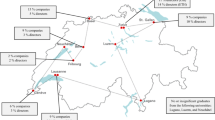Abstract
This study examines empirically if corporate headquarters location matters for board leadership structure under different asymmetric information settings. We examine the impact of corporate headquarters location on CEO duality for the period 1998–2013. Using the Metropolitan Statistical Area (MSA) to define the location of corporate headquarters, we find that metropolitan firms are more likely to have CEO-Chairman duality than rural firms. Utilizing idiosyncratic risk and analyst forecast error or dispersion to proxy for information asymmetry, we find that metropolitan firms are more likely to have CEO-chairman duality than rural firms in the low information asymmetry setting. Our findings suggest that corporate headquarters location is an important determinant of board leadership structure.
Similar content being viewed by others
Notes
For example, studies show that separate leadership is associated with higher information acquisition cost but more effective board monitoring (Fama and Jensen 1983; Jensen 1993; Lipton and Lorsch 1992; Core et al. 1999; Goyal and Park 2002). In the same vein, the literature suggests that dual leadership reduces information cost, leading to a better firm performance (Anderson and Anthony 1986; Brickley et al. 1997; Finkelstein and D’Aveni 1994; Adams et al. 2005; Larcker and Tayan 2011).
We thank an anonymous reviewer for suggesting this proxy.
Results of using subsamples are not tabulated but are available upon request.
Results of using subsamples are not tabulated but are available upon request.
References
Adams RB, Ferreira D (2007) A theory of friendly boards. J Financ 62(1):217–250
Adams RB, Almeida H, Ferreira D (2005) Powerful CEOs and their impact on corporate performance. Rev Financ Stud 18:1403–1432
Alam ZS, Chen MA, Ciccotello CS, Ryan HE (2014) Does the location of directors matter? Information acquisition and board decisions. J Financ Quant Anal 49:131–164
Anderson CA, Anthony RN (1986) The new corporate directors: insights for board members and executives. Wiley, New York
Boone A, Field L, Karpoff J, Raheja C (2007) The determinants of corporate board size and composition: an empirical analysis. J Financ Econ 85:66–101
Booth J, Deli D (1999) On executives of financial institutions as outside directors. J Corp Finan 5:227–250
Borokhovich K, Parrino R, Trapani T (1996) Outside directors and CEO selection. J Financ Quant Anal 31:377–397
Brickley JA, Coles JL, Jarrell G (1997) Leadership structure: separating the CEO and chairman of the board. J Corp Finan 3:189–220
Coles J, Daniel N, Naveen L (2008) Boards: does one size fit all. J Financ Econ 87:329–356
Core JE, Holthausen RW, Larcker DF (1999) Corporate governance, chief executive officer compensation, and firm performance. J Financ Econ 51:371–406
Donaldson L, Davis JH (1991) Stewardship theory or agency theory: CEO governance and shareholder returns. Aust J Manag 16:49–64
Duchin R, Matsusaka JG, Ozbas O (2010) When are outside directors effective. J Financ Econ 96:195–214
Eisenhardt KM (1989) Agency theory: an assessment and review. Acad Manag Rev 14:57–74
Faleye O (2007) Does one hat fit all? The case of corporate leadership structure. J Manag Gov 11:239–259
Fama E, Jensen M (1983) Separation of ownership and control. J Law Econ 26:301 325
Fee C, Hadlock C (2004) Managerial turnover across the corporate hierarchy. J Account Econ 37:3–38
Fich EM, Shivdasani A (2006) Are busy boards effective monitors? J Financ 61:689–724
Finkelstein S, D’Aveni RA (1994) CEO duality as a double-edged sword: how board of directors balance entrenchment avoidance and unity of command. Acad Manag J 37:1079–1108
Gao W, Ng L, Wang Q (2011) Does corporate headquarters location matter for firm capital structure? Financ Manag 40:113–138
Goyal VK, Park CW (2002) Board leadership structure and CEO turnover. J Corp Finan 8:49–66
Hermalin B, Weisbach M (1998) Endogenously chosen boards of directors and their monitoring of the CEO. Am Econ Rev 88:96–118
Hou K, Moskowitz TJ (2005) Market frictions, price delay, and the cross-section of expected returns. Rev Financ Stud 18:981–1020
Huson M, Parrino R, Starks L (2001) Internal monitoring mechanism and CEO turnover: a long-term perspective. J Financ 56:2265–2297
Jensen M (1986) Agency costs of free cash flow, corporate finance, and takeovers. Am Econ Rev 76:323–329
Jensen M (1993) The modern industrial revolution, exit, and the failure of internal control systems. J Financ 48:831–880
John K, Knyazeva A, Knyazeva D (2011) Does geography matter? Firm location and corporate payout policy. J Financ Econ 101:533–551
Krause R, Semadeni M, Cannella AA Jr (2014) CEO duality: a review and research agenda. J Manag 40:256–286
Krishnaswami S, Subramaniam V (1999) Information asymmetry, valuation, and the corporate spin-off decision. J Financ Econ 53:73–112
Larcker D, Tayan B (2011) Corporate governance matters: a closer look at organizational choices and their consequences. In: Upper Saddle River. Pearson Education Inc, New Jersey
Lehn K, Patro S, Zhao M (2004). Determinants of the size and structure of corporate boards: 1935–2000. Unpublished working paper, University of Pittsburgh
Linck J, Netter J, Yang T (2008) The determinants of board structure. J Financ Econ 87:308–328
Lipton M, Lorsch J (1992) A modest proposal for improved corporate governance. The Business Lawyer 48:59–77
Loughran T (2008) The impact of firm location on equity issuance. Financ Manag 37:1–21
Loughran T, Schultz P (2005) Liquidity: urban vs. rural firms. J Financ Econ 78:341–374
Raheja C (2005) Determinants of board size and composition: a theory of corporate boards. J Financ Quant Anal 40:283–306
Uysal VB, Kedia S, Panchapagesan V (2008) Geography and acquirer returns. J Financ Intermed 17:256–275
Zhang J, Chung J (2018) Does geographical location matter for managerial compensation design. J Econ Financ 42:1–32
Author information
Authors and Affiliations
Corresponding author
Additional information
Publisher’s note
Springer Nature remains neutral with regard to jurisdictional claims in published maps and institutional affiliations.
Rights and permissions
About this article
Cite this article
Borah, N., James, H. Board leadership structure and corporate headquarters location. J Econ Finan 44, 35–58 (2020). https://doi.org/10.1007/s12197-019-09475-7
Published:
Issue Date:
DOI: https://doi.org/10.1007/s12197-019-09475-7




